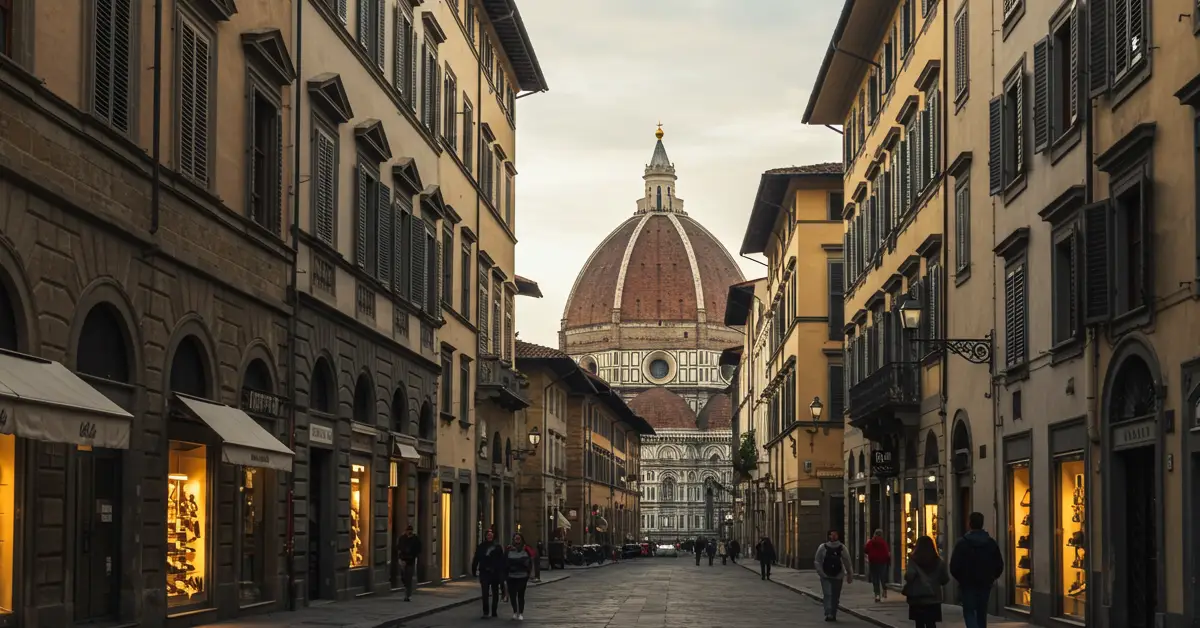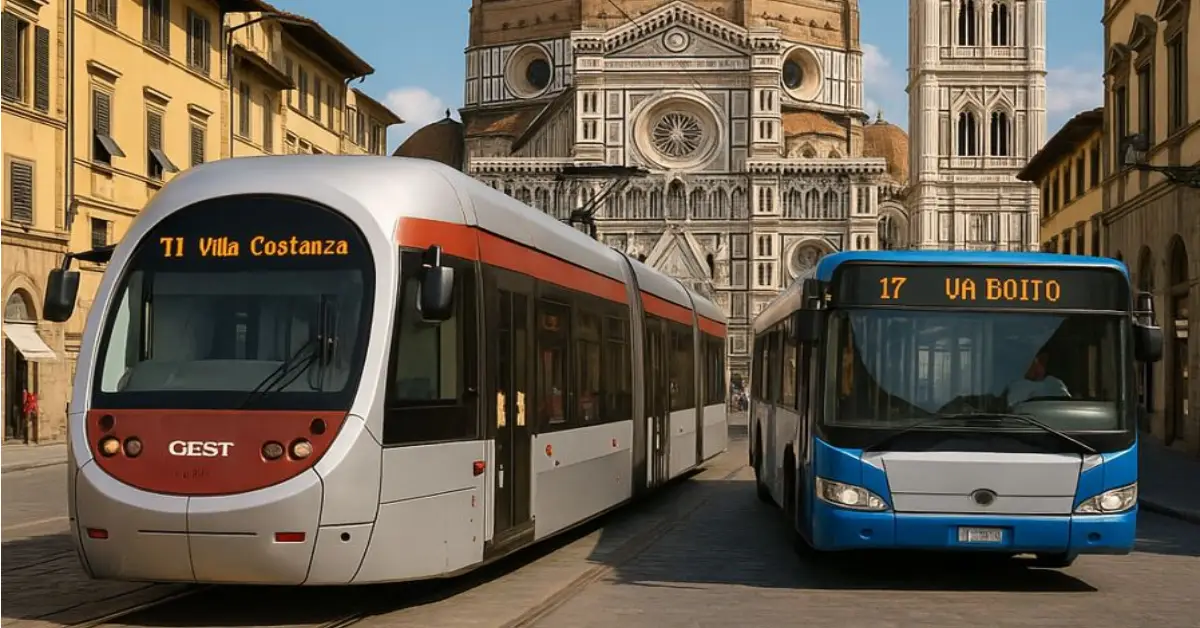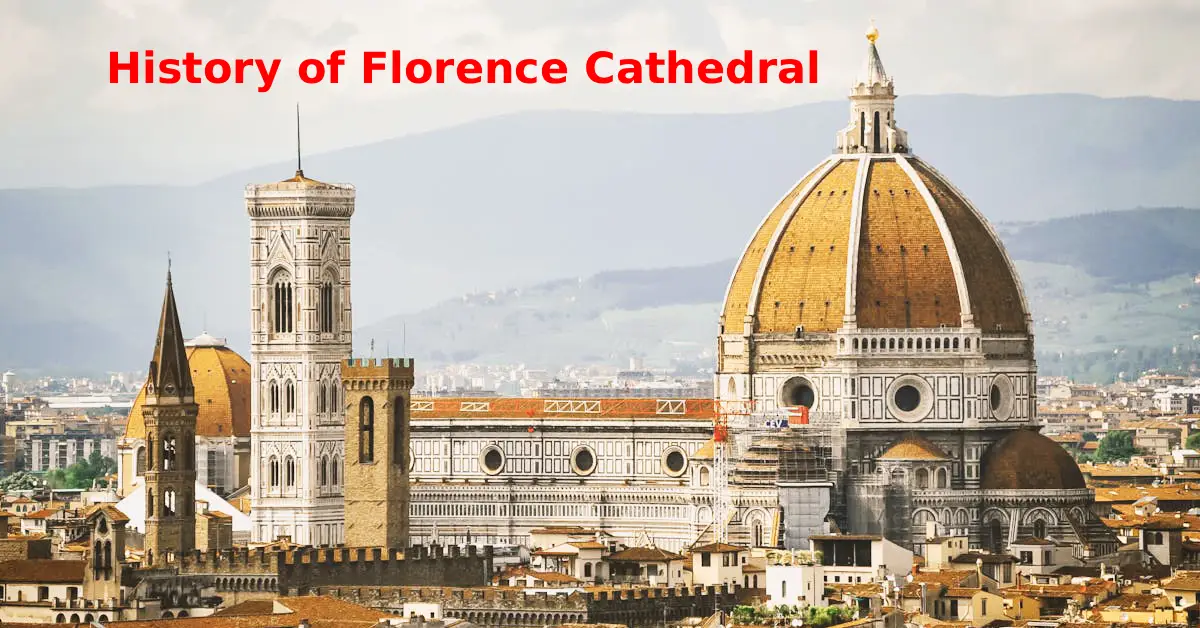Florence, the birthplace of the Renaissance, offers visitors an unforgettable experience with its rich history, art, and architecture. The city’s charming streets, vibrant culture, and mix of art, science, and spirituality provide a unique experience that immerses travelers in centuries of creativity and innovation.
One of the most iconic attractions is the Florence Duomo Cathedral. A guided tour of the cathedral allows visitors to explore the intricate details of the Cupola del Brunelleschi. Climbing to the Duomo top is one of the most unique experiences in Florence, offering breathtaking panoramic views of the entire city.
Just steps away, the Campanile di Giotto and Museo dell’Opera del Duomo further enrich the experience of this architectural wonder. Art enthusiasts will find themselves captivated at the Uffizi Gallery and Uffizi Art Museum, home to masterpieces by Botticelli and Michelangelo, and the Galleria dell’Accademia, where Michelangelo’s “David” stands proudly.
History flows through every corner of Florence, from the medieval streets of Centro Storico to the grand Palazzo Vecchio and Piazza della Signoria, where statues and fountains offer a glimpse into the past. Do not forget to visit the stunning San Miniato al Monte for one of the best views of Florence, or head to the famous Piazzale Michelangelo for a breathtaking panoramic view that will truly mesmerize you.
After taking in the sights, enjoy a peaceful retreat by wandering through the lush Boboli Gardens or Palazzo Pitti, a symbol of Florence’s Medici family legacy.
The city’s charm extends to spiritual landmarks like the Basilica of Santa Croce and the Church of Orsanmichele, where art and faith intersect. Complete your Florence journey by exploring beautiful spots like the Fontana del Porcellino and the Leonardo Interactive Museum.
Do not forget to visit the Museo Galileo for unique experiences and fascinating scientific breakthroughs, with many attractions offering free options for a budget-friendly adventure.
What are the best things to do in Florence?
The best things to do in Florence are mentioned below.
1: Visit The Florence Duomo/Cathedral of Santa Maria del Fiore
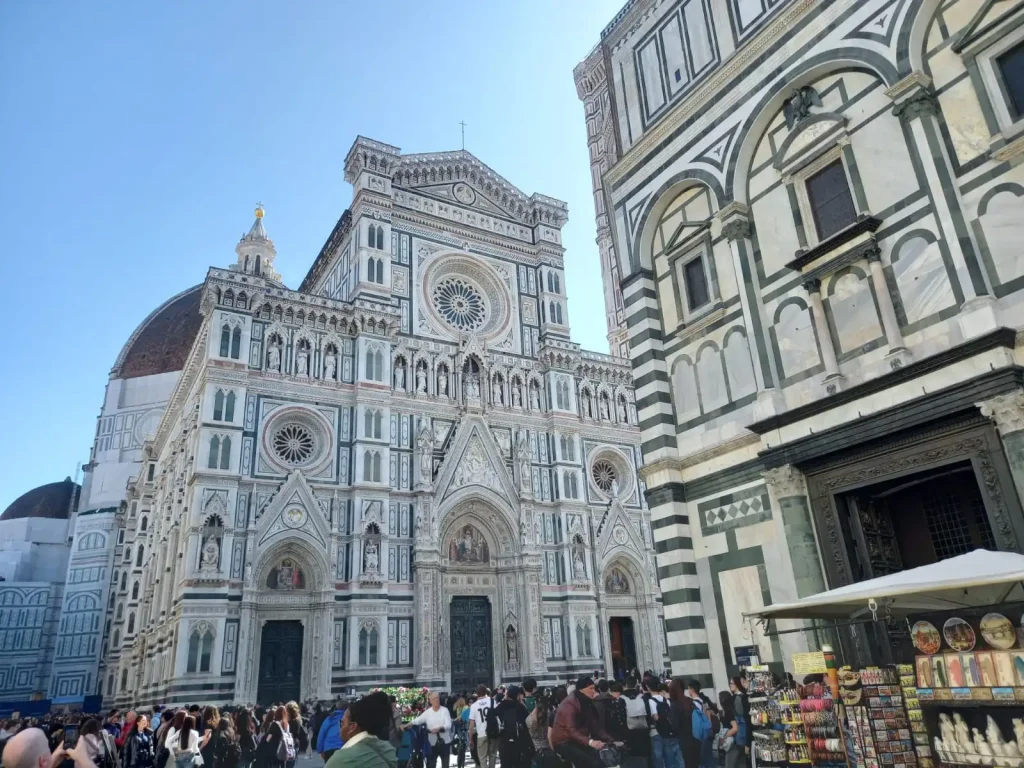
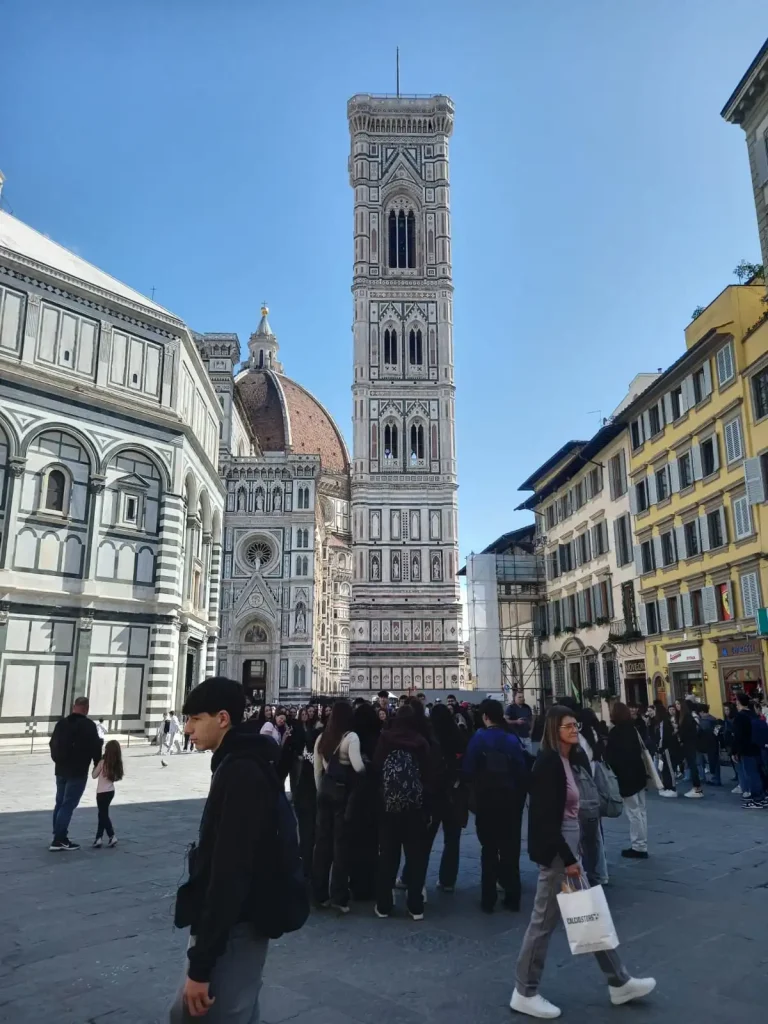
A visit to the Florence Duomo provides more than a glimpse of the city’s past; it offers an encounter with a masterpiece of human ingenuity and artistry, making it an essential stop for anyone exploring Italy’s cultural treasures.
The Florence Duomo, officially known as the Cathedral of Santa Maria del Fiore, symbolizes the city’s architectural brilliance and rich history. Built between 1296 and 1436, the cathedral features a remarkable dome designed by Filippo Brunelleschi, which revolutionized engineering with its massive scale and innovative construction techniques. Over the centuries, the Duomo has become a testament to Florence’s cultural and artistic heritage, reminding visitors of the creativity and passion that shaped the heart of Renaissance Italy.
According to Florence-Tickets, the Duomo attracts up to two million visitors annually. Notably, 52% of these tourists come from the United States, followed by 18% from China and 7% from the United Kingdom. Its popularity stems from a unique blend of historical significance, architectural innovation, and breathtaking views from the top of the dome.
Visitors can explore the remarkable frescoes by Giorgio Vasari, which vividly illustrate biblical tales, along with the cathedral’s elaborate exterior, a captivating canvas that narrates Florence’s rich cultural journey.
For the best experience, plan your trip during spring (April-May) or early fall (September-October) when the weather is pleasant and crowds are more manageable. Expect expenses of about €20 to €50, which cover entrance fees and guided tours, with the option to add a Dome and Bell Tower climb for deeper insights into the cathedral’s history.
2: Visiting Ufizzi Gallery Florence
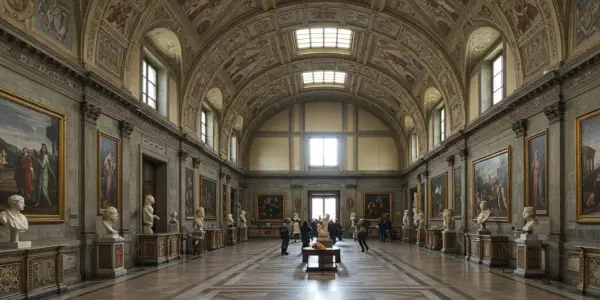
The Uffizi Gallery in Florence ranks among the world’s most renowned art museums, with a rich history dating back to 1584. Originally designed by Giorgio Vasari for the ruling Medici family, it was meant to house their extensive collection of art and artifacts. Today, the gallery showcases masterpieces by legendary artists such as Botticelli, Michelangelo, and Caravaggio, making it essential for art enthusiasts.
Its popularity stems from the extraordinary range of artworks spanning centuries, offering a glimpse into the evolution of art and culture. Highlights include Botticelli’s iconic “Birth of Venus” and da Vinci’s exquisite “Annunciation,” both captivating audiences with their beauty and historical significance.
Visitors flock to the Uffizi not only for the art but also for the stunning architecture and the chance to explore Florence’s rich heritage. Admission typically costs between €20 and €50, with options for skip-the-line access and guided tours, enhancing the experience of the gallery’s renowned collection.
The best times to visit Florence are during the shoulder seasons of spring (April-May) and early fall (September-October), when the weather is pleasant and crowds are smaller. A trip to the Uffizi Gallery promises a memorable journey through art history, ensuring that every visitor leaves with lasting impressions and a deeper appreciation for the beauty of Renaissance art.
Do not miss the opportunity to walk in the footsteps of great masters and experience the magic that continues to inspire countless artists today.
3: Touring Galleria del’Accademia
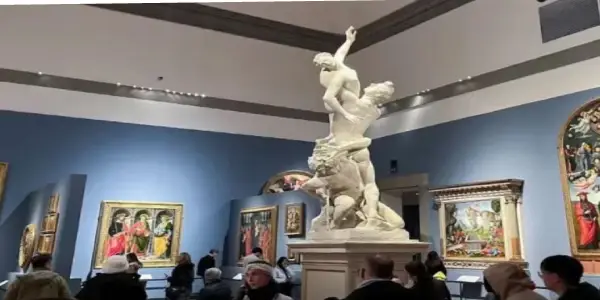
The Accademia Gallery in Florence, founded in 1784, is best known for housing Michelangelo’s masterpiece, David. Originally established by Grand Duke Leopold of Tuscany as a fine arts academy, the museum has since become a major attraction, drawing millions eager to see one of the most famous sculptures in history.
Beyond David, the Accademia holds a remarkable collection of Renaissance art, including Michelangelo’s unfinished Prisoners, Giambologna’s Rape of the Sabine Women, and works by Florentine masters like Botticelli and Ghirlandaio. The museum also features an extensive section dedicated to historical musical instruments, showcasing pieces from the Medici and Lorraine collections.
Admission tickets range from €16 to €45, with options for guided tours to bypass long queues. The best times to visit are early mornings or late afternoons on weekdays, particularly from April to May or September to October, when Florence experiences fewer crowds.
A visit to the Accademia Gallery offers a rare chance to witness Michelangelo’s genius up close while exploring the artistic heritage of Florence. This experience provides an essential glimpse into the city’s creative legacy and the enduring influence of the Renaissance.
4: Visiting Medici Chapel
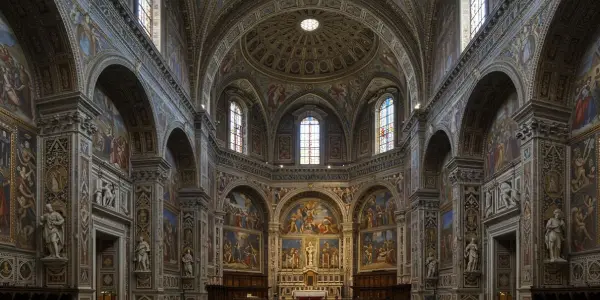
The Medici Chapel, located in Florence, represents the power and influence of the Medici family during the Renaissance. Built between 1520 and 1534, it serves as the burial place for many members of this prominent family. The chapel is renowned for its impressive architecture and exquisite sculptures created by Michelangelo, particularly the notable “Day” and “Night” figures that adorn the tombs of Lorenzo and Giuliano de’ Medici.
Visitors are drawn to the Medici Chapel for its rich history and artistic significance, showcasing the Medici’s patronage of the arts. The intricate decorations and lavish interiors offer a glimpse into the opulence of Renaissance Florence, making it a must-see for art lovers and history enthusiasts alike.
Entrance fees typically range from €5 to €10, making it an accessible destination for many travelers. A visit to the Medici Chapel provides an opportunity to experience its stunning artistry and rich history, ensuring that every euro spent is worthwhile.
Florence shines in early spring and early fall, offering mild weather, fewer crowds, and a lively atmosphere. This allows visitors to immerse themselves fully in the city’s art, history, and local culture.
A trip to the Medici Chapel promises an unforgettable experience that deepens one’s understanding of Florence’s cultural heritage, making it a captivating destination where art and history come to life in every detail.
5: Exploring Boboli Gardens
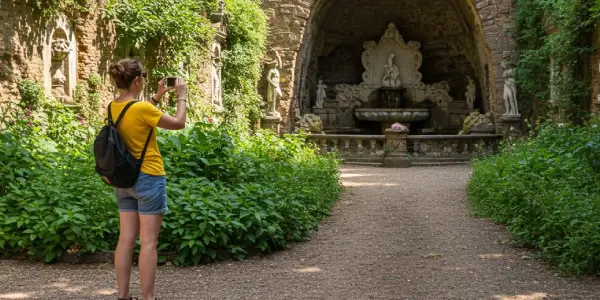
The Boboli Gardens, located in Florence, are among Italy’s most famous gardens, known for their historical significance and artistic features. Originally designed in the 16th century for the Medici family, these gardens spread across 111 acres and provide a blend of nature and Renaissance architecture.
Tourists can enjoy a variety of sculptures, fountains, and grottoes, including the striking Neptune Fountain and the mysterious Buontalenti Grotto. Main attractions include panoramic views of Florence, the grand Amphitheater with ancient statues, and the Isolotto, a small island with statues that create an enchanting atmosphere. The vast collection of art and sculptures throughout the gardens makes it a cultural landmark.
A single ticket costs €10, while the combined ticket for Pitti Palace and Boboli Gardens is €22. Discounts and free entry are offered for eligible groups, such as children, students, people with disabilities, and EU citizens under 18.
To reach the Boboli Gardens from Florence’s city center, a 15-minute walk from the Piazza Duomo area brings you there. Alternatively, a short bus ride to the Porta Romana gate will get you close. However, tourists from all over the world love exploring Florence on foot to fully experience its rich history and charm.
These gardens offer a peaceful escape from the bustling city while immersing visitors in the beauty of Florence’s past, providing the perfect backdrop for unforgettable memories and stunning photographs.
6: Walking on Ponte Vecchio
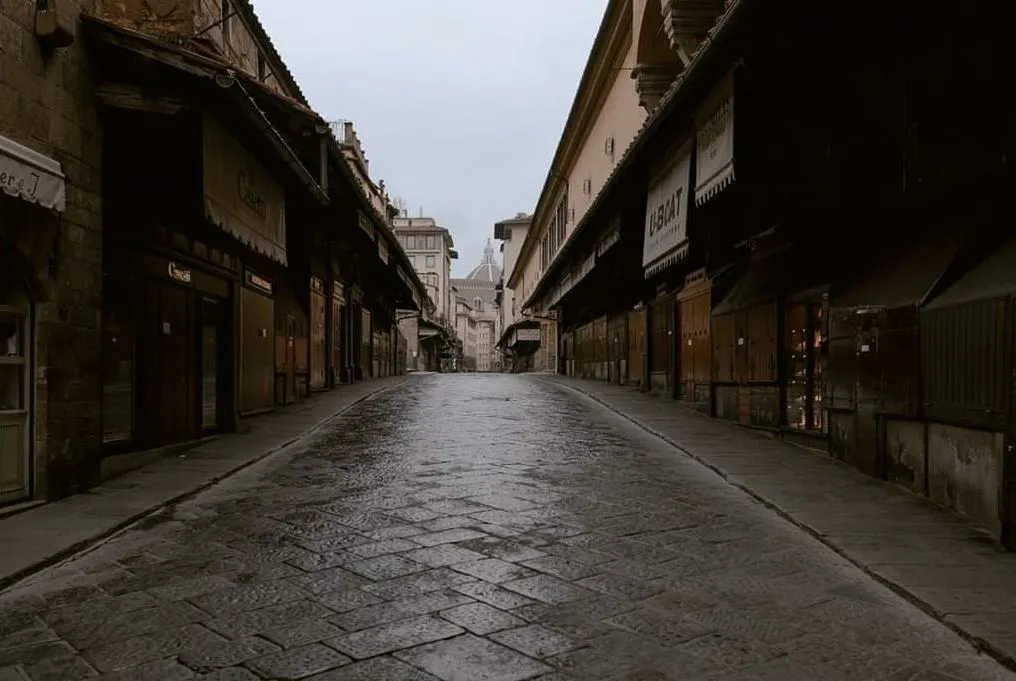
The Ponte Vecchio, or “Old Bridge,” is one of Florence’s most iconic landmarks, boasting a rich history that dates back to the 14th century. Originally built in 1333, it was the only bridge in Florence to survive World War II, earning its place as a symbol of resilience. The bridge’s charming shops and lively street performances make it a favorite spot for those seeking to immerse themselves in Florentine culture.
Every year, over 1.5 million tourists visit the Ponte Vecchio, eager to capture its beauty and history. It is particularly romantic at sunset when the golden light casts a warm glow, enhancing the bridge’s charm and creating the perfect backdrop for memorable photographs.
Today, the Ponte Vecchio is famous for its unique shops, particularly jewelers and artisans, creating a vibrant atmosphere that attracts visitors year-round. Tourists flock to this historic bridge not only for its stunning architecture but also for the breathtaking views of the Arno River and the surrounding cityscape.
Whether you wander its charming cobblestone paths during the day or enjoy a peaceful moment at sunset, the Ponte Vecchio is a must-visit for anyone eager to soak in the magic of Florence. This bridge, with its rich history, stunning artistry, and romantic atmosphere, offers an unforgettable experience that stays with you long after you’ve left.
7: Visiting Piazzale Michelangelo Top
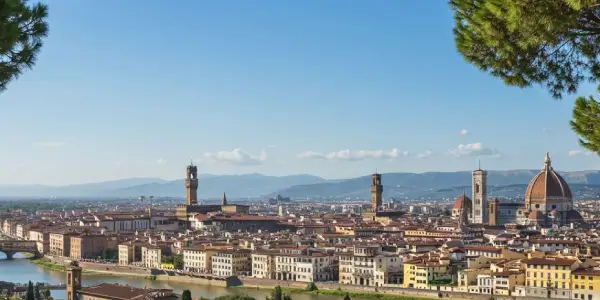
Piazzale Michelangelo is a stunning square at the top of Florence, offering panoramic views of the city and the iconic Duomo. Designed in 1869 by architect Florentine Giuseppe Poggi, this square was built to celebrate the art and culture of the Renaissance. It is renowned for its breathtaking vistas, making it a popular spot for both tourists and locals alike.
Visitors flock to Piazzale Michelangelo for its remarkable views of Florence from the top, especially at sunrise and sunset when the city is bathed in golden light. The square features a replica of Michelangelo’s David, adding a touch of artistry to the experience.
You can easily reach Piazzale Michelangelo by taking a relaxing walk from the city center, which takes about 30 minutes, or by hopping on a bus that runs frequently.
At Piazzale Michelangelo, visitors can enjoy scenic gardens, sit on benches, and capture stunning photographs of Florence’s skyline. The atmosphere is lively, with street performers and artists adding to the charm. The best part is that visiting the square is completely free, making it affordable for everyone.
Tourists love to visit Piazzale Michelangelo not just for the views but for the sense of connection it provides to the beauty and history of Florence. This destination promises an unforgettable experience, inviting all to relax in the city’s rich heritage and capture stunning photos that will last a lifetime.
8: Visiting Basilica of Santa Croce
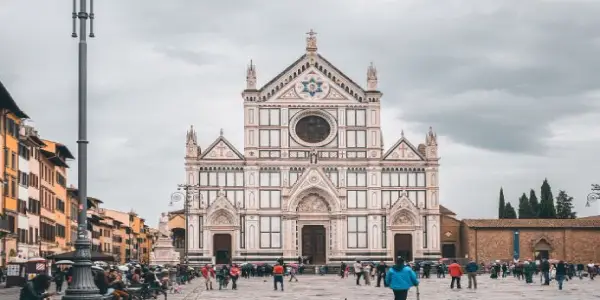
The Basilica of Santa Croce, located in Florence, is a historic landmark dating back to 1294. Known as the “Temple of the Italian Glories,” it is famous for housing the tombs of iconic figures like Michelangelo, Galileo, and Machiavelli. The basilica’s stunning Gothic architecture and rich history make it a must-visit for those interested in art, culture, and history.
Tourists gather at the Basilica of Santa Croce for its beautiful frescoes by Giotto, the impressive cloisters, and the famous Pazzi Chapel, which adds to the Basilica’s charm. The monumental tombs of Italy’s greats create a sense of connection with history that resonates deeply with visitors.
The monumental complex of Santa Croce welcomes thousands of visitors every year who flock to discover its immense historical and artistic heritage. Entry to the basilica costs €8, which includes access to the church, cloisters, and the museum.
To make the most of the visit, it’s best to go early in the morning or later in the afternoon to avoid the crowds and enjoy the peaceful atmosphere. A guided tour with some extra payment can enhance the experience, offering insights into the artwork and the lives of the historical figures buried there.
Tourists should not miss this remarkable site, as it offers more than just a visit; it provides a journey through the heart of Florence’s Renaissance heritage. The Basilica of Santa Croce promises an experience that goes beyond sightseeing, inviting everyone to connect with the spirit of Italy’s cultural and artistic past.
9: Exploring Piazza Della Signoria
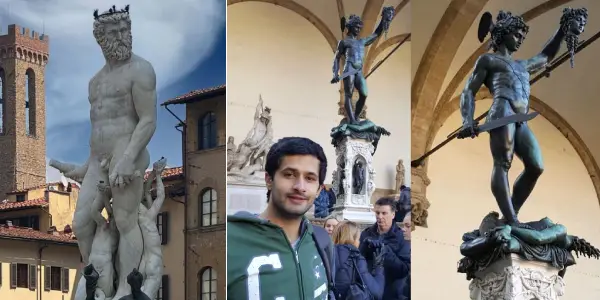
Piazza della Signoria, located in the heart of Florence, is a historic square that traces its roots to the 13th century. It has served as the city’s political center for centuries and remains a symbol of Florence’s rich history. The square is surrounded by iconic landmarks like Palazzo Vecchio, the city’s town hall, and is adorned with famous sculptures, including a replica of Michelangelo’s David and Cellini’s Perseus.
Tourists flock to Piazza della Signoria to experience its open-air museum feel, where art and history are on full display. The Loggia dei Lanzi, with its impressive collection of Renaissance sculptures, and the Fountain of Neptune, are among the captivating sights that draw visitors in. The lively atmosphere, with street performers and bustling cafes, adds to the charm of this vibrant gathering place.
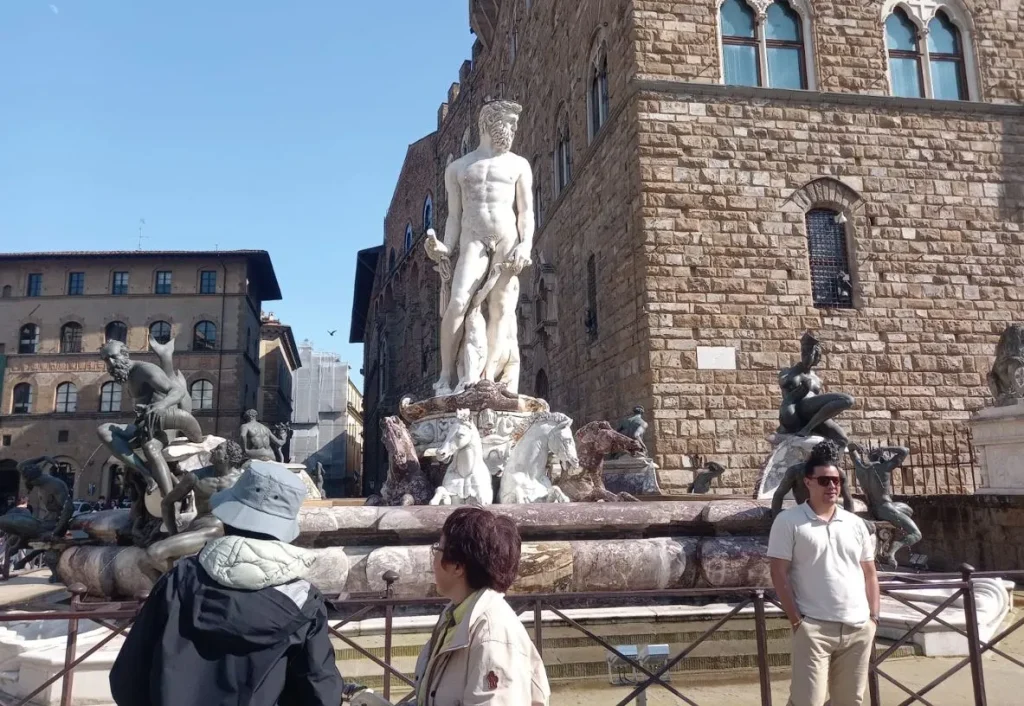
Visiting Piazza della Signoria is completely free of charge, allowing everyone to enjoy its beauty without any cost. For the best experience, visitors can explore the square early in the morning or late in the afternoon to avoid crowds, or sit at a nearby cafe and take in the views.
Tourists shouldn’t miss this iconic square, as it offers a unique opportunity to immerse themselves in the history and culture of Florence. With its stunning architecture, remarkable sculptures, and lively atmosphere, Piazza della Signoria provides an unforgettable experience that captures the spirit of the city, making it a must-visit destination for anyone wanting to truly appreciate Florence’s rich cultural heritage.
10: Visiting Palazzo Vecchio
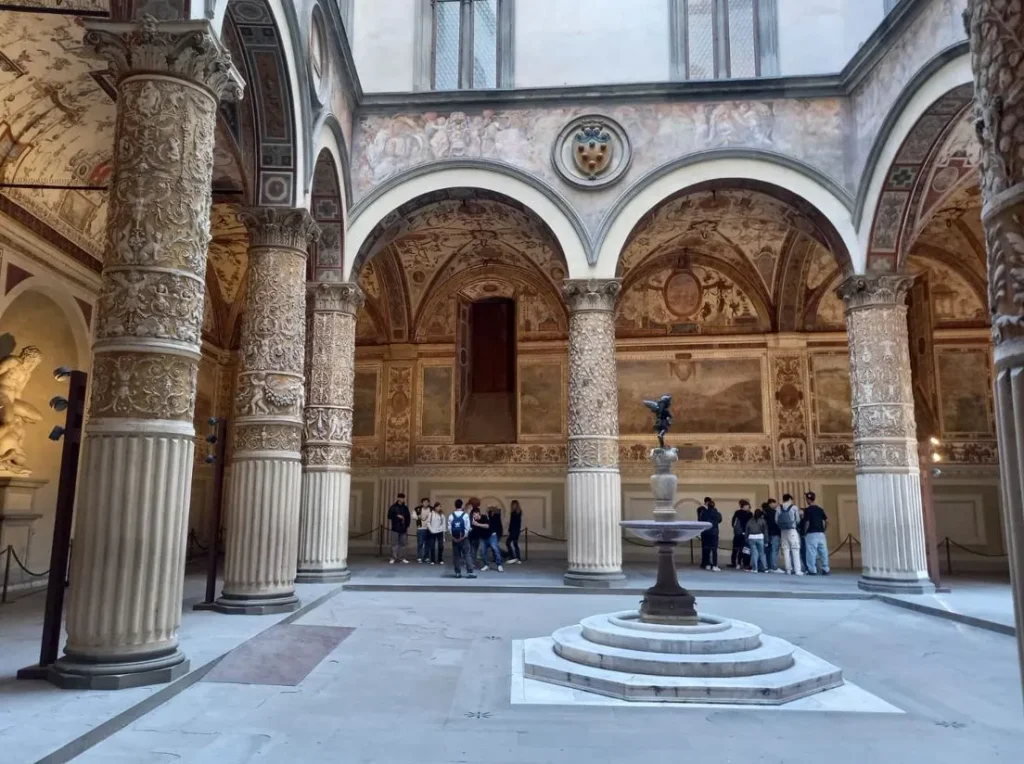
Palazzo Vecchio, the historic town hall of Florence, has stood since the late 13th century as a symbol of the city’s political power. Originally built as a fortress for the Florentine Republic, it is renowned for its impressive medieval architecture and stunning frescoed interiors.
Today, the palace is a museum, attracting visitors with its rich history and artistic treasures. Tourists visit the Palazzo Vecchio to explore its magnificent rooms, including the Salone dei Cinquecento, adorned with intricate frescoes and sculptures. Each corner of Palazzo Vecchio offers a discovery, making every moment spent here a step back in time.
The tower offers panoramic views of Florence, allowing visitors to admire the city’s stunning architecture and landmarks from a breathtaking vantage point. Additionally, the Courtyard of Michelozzo and the Hall of the Element showcase exquisite artworks that reflect the Renaissance spirit.
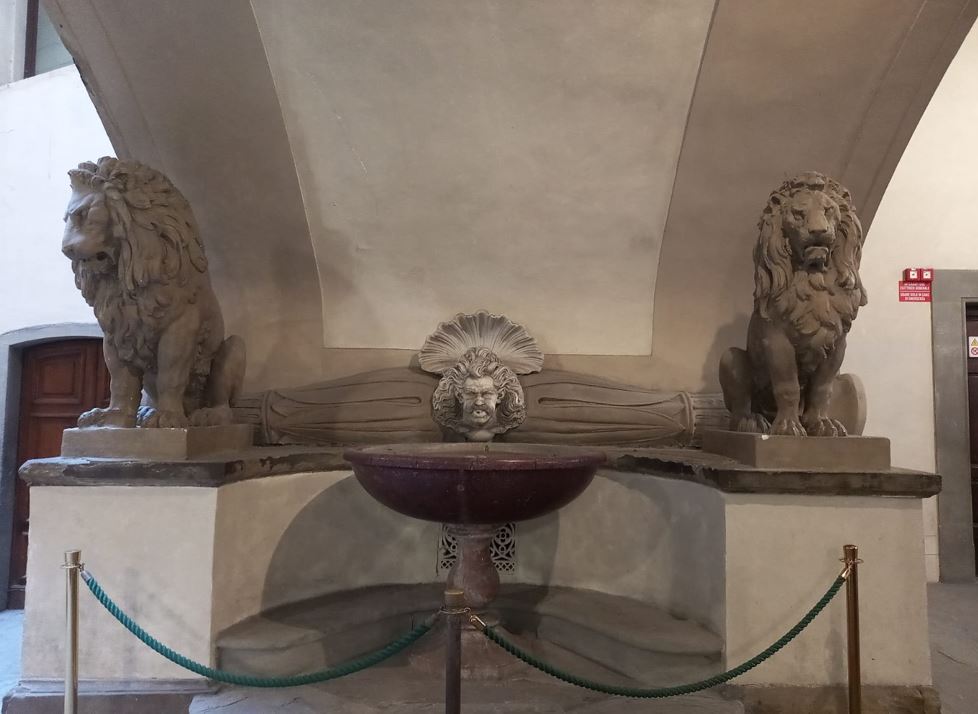
Entry to Palazzo Vecchio costs approximately €10, which includes access to the museum and the tower. To make the most of your visit, consider joining a guided tour to gain deeper insights into its history and art.
Do not miss the Palazzo Vecchio, as it offers a captivating glimpse into Florence’s past while embodying the grandeur of its architectural heritage. With its stunning artwork, impressive architecture, and rich history, Palazzo Vecchio promises an unforgettable experience for anyone exploring this vibrant city.
11: Touring Museo Nazionale del Bargello
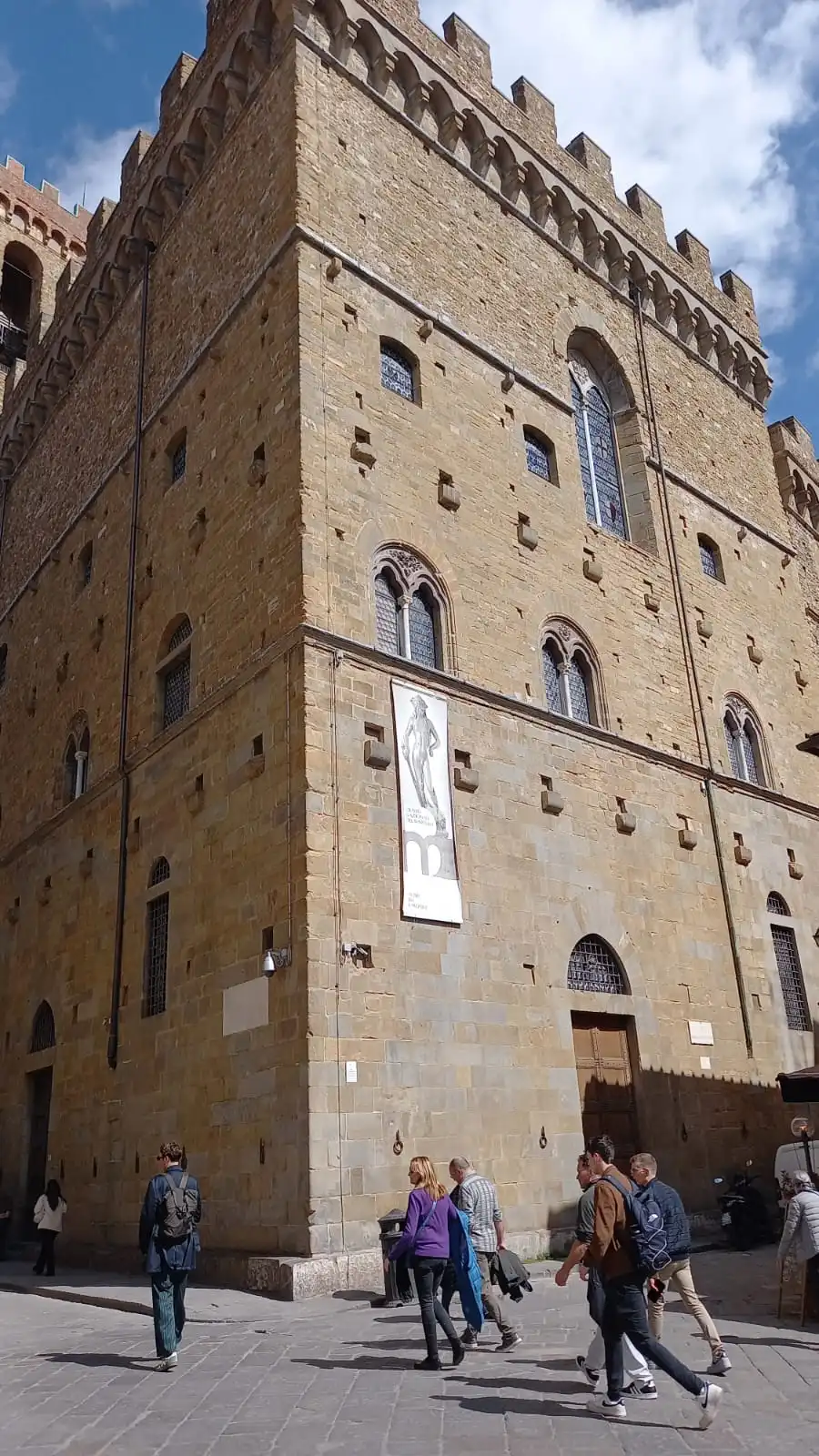
Museo Nazionale del Bargello, housed in a former barracks and prison, is one of Florence’s oldest museums, established in 1865. This historic building, dating back to the 13th century, showcases an impressive collection of Renaissance art, particularly renowned for its exquisite sculptures.
Visitors come to the Bargello to admire masterpieces by iconic artists such as Michelangelo, Donatello, and Verrocchio, with highlights including Donatello’s David and the stunning Marble Bacchus by Michelangelo.
The museum’s intimate setting allows for an up-close encounter with these masterpieces, making it a favorite among art lovers and tourists. Entry to the Bargello costs approximately €10, providing access to a wealth of history and artistry. For those looking to deepen their understanding, guided tours are available, enhancing the overall experience.
In addition to its incredible sculptures, the museum features a beautiful courtyard and a collection of decorative arts, offering a comprehensive glimpse into the creativity of the Renaissance. Visitors can also enjoy fascinating temporary exhibitions that highlight various aspects of art history, enhancing the overall experience.”
“People visit the Museo Nazionale del Bargello to admire masterpieces by iconic artists such as Michelangelo, Donatello, and Verrocchio, with highlights including Donatello’s David and the Marble Bacchus by Michelangelo. This museum promises an unforgettable journey through the heart of Renaissance art, offering a rare chance to see some of history’s most celebrated sculptures up close.
12: Visiting San Miniato al Monte
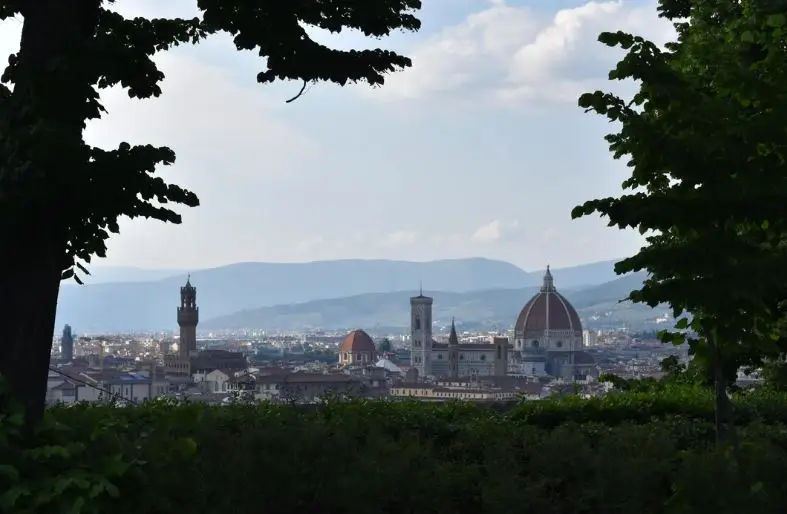
San Miniato al Monte, a historic basilica in Florence, stands as one of the city’s oldest and most beautiful churches. Founded in 1018, it honors Saint Minias, an early Christian martyr. The Romanesque-style architecture, featuring intricate marble patterns and an impressive facade, draws visitors eager to explore its centuries-old charm.
San Miniato’s interior captivates with stunning frescoes, including works by Spinello Aretino, and the impressive mosaic of Christ between the Virgin and St. Minias. The marble inlaid floor, geometric designs, and the crypt’s evocative atmosphere further highlight the basilica’s artistic and spiritual appeal.
Tourists are drawn here not just for its beauty, but for the panoramic views over Florence. Positioned on a hilltop, the basilica offers a sweeping perspective of the city’s iconic landmarks, providing an ideal spot for photography and quiet contemplation.
The basilica is free to enter, making it an accessible destination for all. Visitors can experience the serene atmosphere and catch daily vespers sung by monks in Gregorian chant, adding a unique cultural touch.
To enjoy San Miniato fully, arrive during late afternoon to witness the sunset over Florence, or attend a special mass. A visit here provides a peaceful retreat from the city’s busy streets and a chance to appreciate Florence’s history from a different vantage point. Missing out on San Miniato al Monte would mean overlooking a key part of Florence’s rich cultural and artistic heritage.
13: Taking Pictures at Campanile di Giotto
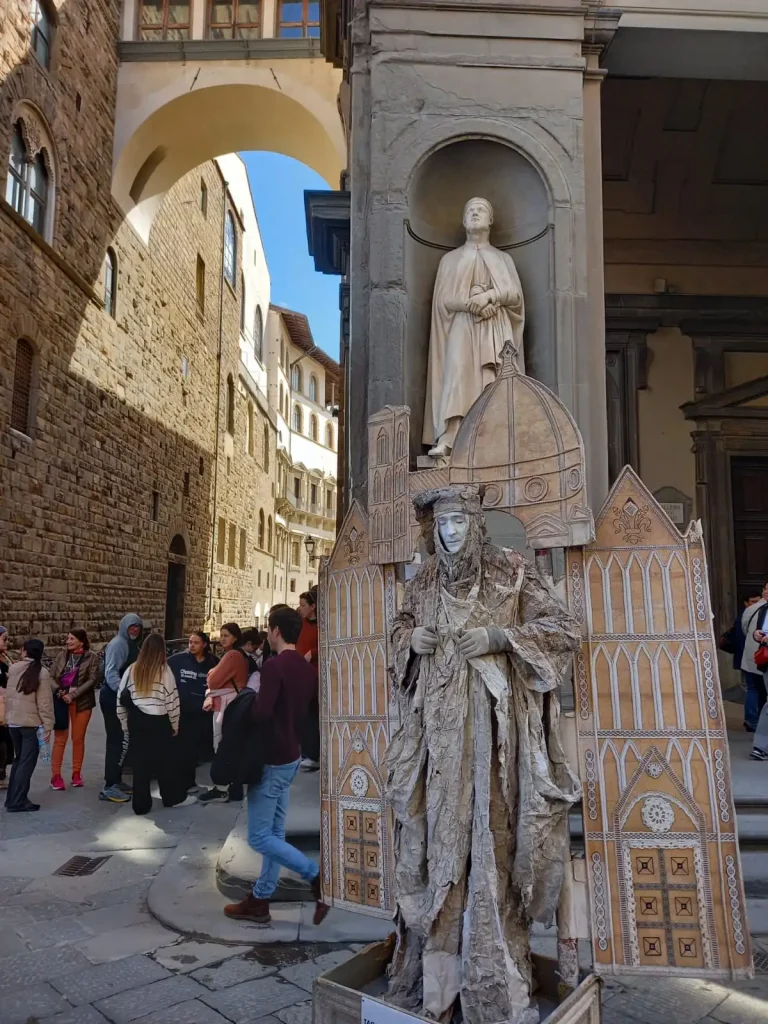
Campanile di Giotto, the bell tower of Florence‘s Cathedral, dates back to 1334 when famed artist Giotto began its design. This Gothic masterpiece is known for its colorful marble façade and intricate sculptures, attracting many visitors.
Standing 84.70 meters tall, it offers breathtaking views of Florence‘s skyline from the top. Climbing its 414 steps rewards tourists with an unmatched perspective of the city and the nearby Cathedral dome. The tower’s decorative reliefs and statues add to its appeal, reflecting biblical themes and human virtues.
The ticket costs €12, and you’ll need to climb 414 steps, as there are no lifts available. However, the effort is rewarded with the chance to explore this remarkable example of 14th-century Florentine Gothic architecture. Missing the Campanile di Giotto means missing the chance to see one of Florence‘s most iconic structures and its stunning views.
14: Visit Palazzo Piti
Palazzo Pitti, a grand Renaissance palace in Florence, was originally built for the wealthy banker Luca Pitti in the 15th century. Later acquired by the Medici family, it became the royal residence and a symbol of power.
Today, the palace is one of Florence‘s most popular attractions, known for its rich history and magnificent art collections. Inside the palace, visitors can explore the Palatine Gallery, which features masterpieces by Raphael, Titian, and Rubens, as well as the Royal Apartments. The palace also includes the Gallery of Modern Art and the Museum of Costume and Fashion, offering diverse cultural experiences.
Entry requires a ticket, with various options depending on the galleries visited. The palace is not free but worth the price for its historical and artistic significance.
To get the most out of your visit, stroll through the adjacent Boboli Gardens for a relaxing escape. Located on the south side of the Arno River, Palazzo Pitti is easily reached on foot from the Ponte Vecchio bridge.
Skipping Palazzo Pitti means missing out on a key piece of Florence’s cultural heritage, where art, history, and nature come together in one iconic location.
15: Visit Museo Galileo
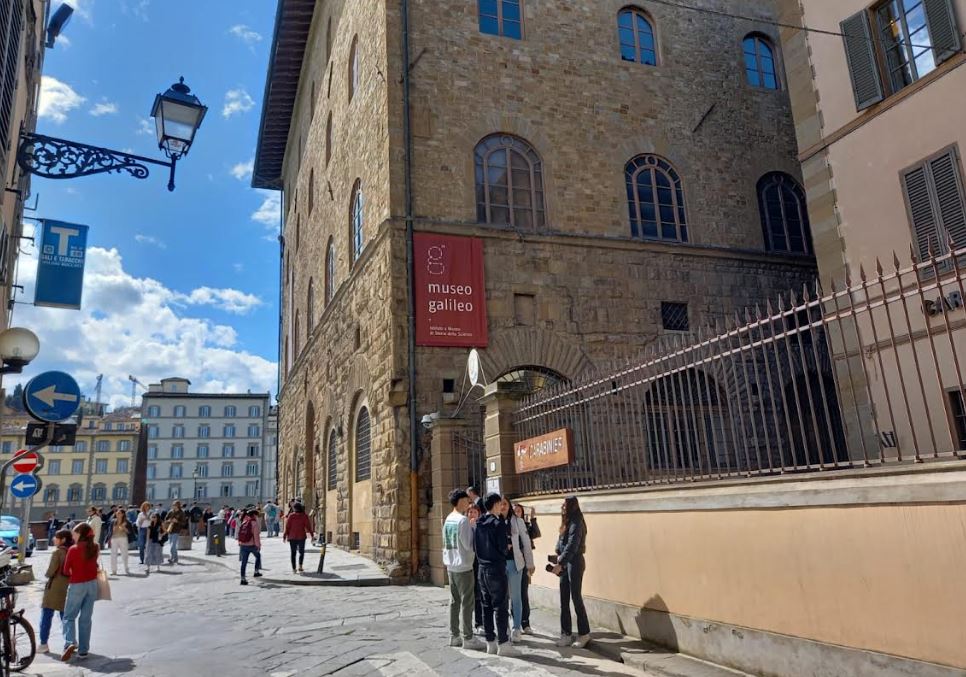
The Museo Galileo in Florence, dedicated to the life and work of Galileo Galilei, houses one of the most significant collections of scientific instruments from the Renaissance and beyond. Opened in 1930 as the Institute and Museum of the History of Science, it was later renamed in honor of Galileo, reflecting his contributions to modern science.
Visitors flock to Museo Galileo to see original instruments used by Galileo, including his telescopes and other groundbreaking tools, as well as historical globes, astrolabes, and early medical instruments. The main highlights include Galileo’s two surviving telescopes and his preserved finger, an unusual artifact for history enthusiasts.
Admission costs approximately €10, with discounts for children and students, making it an accessible experience for all ages. To get the most from the museum, visitors can join a guided tour or explore interactive exhibits that deepen their understanding of scientific advancements.
For those passionate about science and history, Museo Galileo provides an immersive journey into the scientific revolution and a unique glimpse into Galileo‘s world, making it a top attraction in Florence.
16: Visit Loggia dei Lanzi
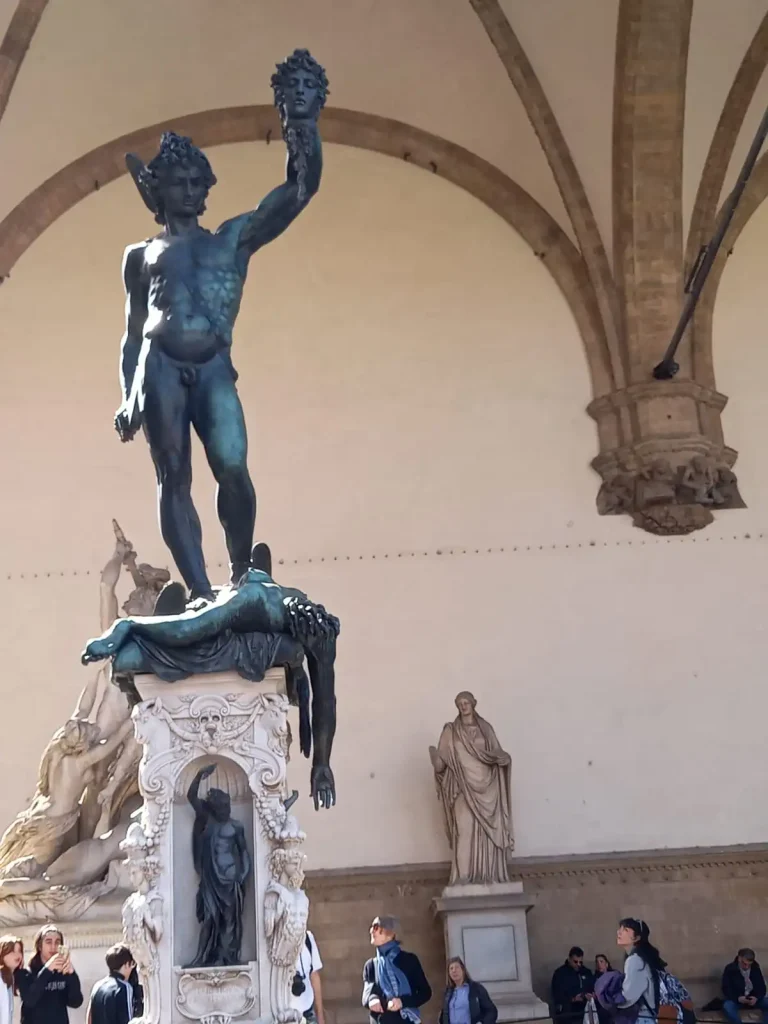
Loggia dei Lanzi, located in Florence’s Piazza della Signoria, is an open-air gallery showcasing Renaissance and Baroque sculptures. Built-in the 14th century, the Loggia was initially a place for public ceremonies but later transformed into a display of art.
Today, it’s famed for its striking sculptures, including Cellini‘s Perseus with the Head of Medusa and Giambologna‘s The Rape of the Sabine Women, each telling powerful stories through detailed artistry.
Tourists love visiting Loggia dei Lanzi for its historical ambiance, artistic mastery, and free admission, making it an accessible cultural experience. For the best visit, spend time observing each statue’s intricacies and read about the stories behind them, adding depth to the experience.
Situated in a prime location, Loggia dei Lanzi presents iconic artworks that provide a remarkable insight into Florence’s artistic heritage, making it an essential stop for every visitor to the city
17: Tour of Church and Museum of Orsanmichele
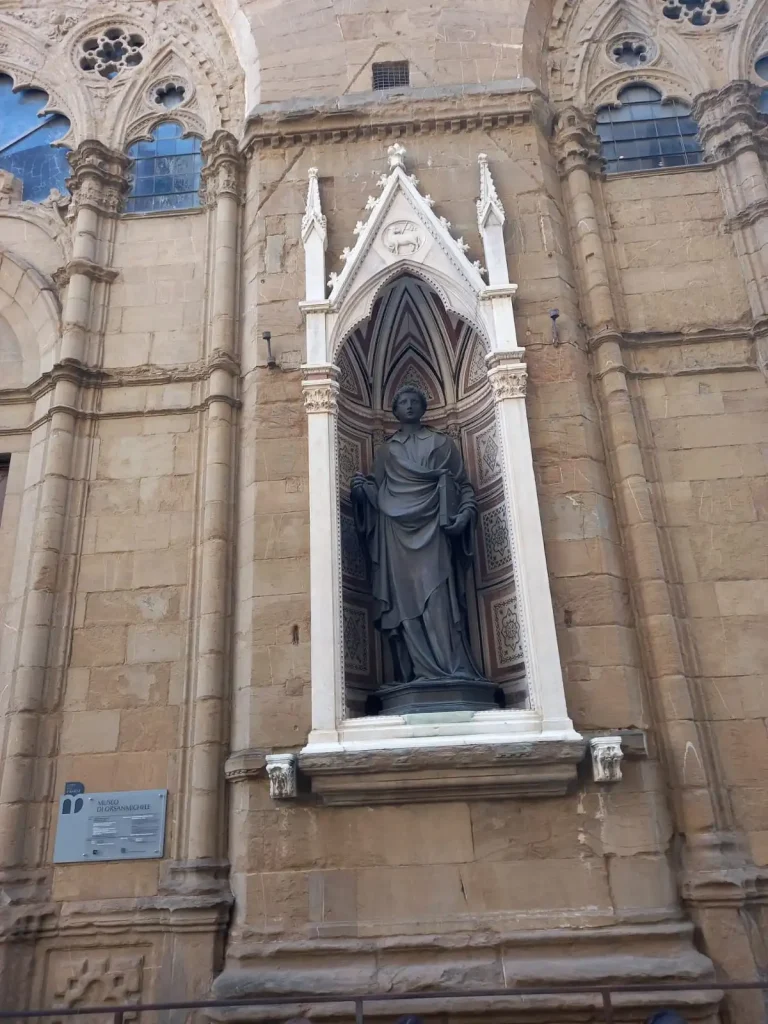
The Church and Museum of Orsanmichele in Florence has a rich history, originating in the 14th century as a grain market before becoming a church dedicated to the Holy Spirit. Known for its stunning Gothic architecture, it attracts art and history enthusiasts with exquisite sculptures.
Famous artworks include Donatello‘s Saint George and Saint Mark, which exemplify early Renaissance sculpture. The church’s unique design features niches that display these masterpieces, allowing visitors to appreciate the craftsmanship closely. Entry to the church is free, while a small fee is required for museum access, providing great value.
To enhance your experience, take your time exploring both the church and museum, and consider using an audio guide or joining a tour for deeper insights.
The Church and Museum of Orsanmichele is a must-visit, offering a fascinating blend of history, art, and architecture that reflects Florence‘s rich cultural heritage.
18: Visit Fontana Del Porcellino
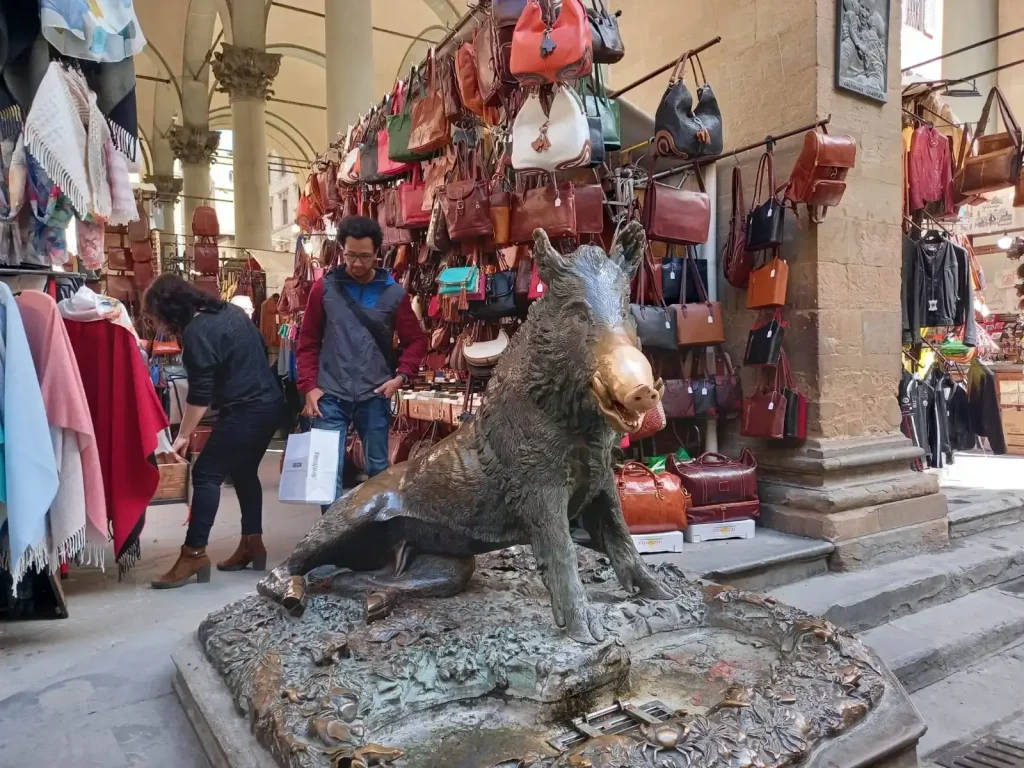
Fontana del Porcellino, located in Florence’s Mercato Nuovo, is a famous bronze fountain featuring a wild boar, created by sculptor Pietro Tacca in the 17th century. The fountain is inspired by an ancient Roman statue and has become a beloved symbol of Florence.
It is popular among tourists for its charming design and the tradition of rubbing the boar’s snout for good luck, ensuring a return to Florence. Visitors are captivated by the intricate details of the boar, which is adorned with a bronze patina from countless touches, symbolizing the city’s connection to luck and prosperity.
The area around the fountain bustles with local vendors and shops, creating a lively atmosphere for tourists to enjoy. Visiting Fontana del Porcellino is free, making it an accessible attraction. To make the most of your visit, take time to observe the fountain, capture photos, and explore the surrounding market.
Fontana del Porcellino is a must-see in Florence, blending history, artistry, and local tradition, offering a unique experience that captures the heart of this vibrant city. Don’t miss the chance to participate in the time-honored tradition of rubbing the boar’s snout and soaking in the lively atmosphere around the fountain.
19: Visit Museo di San Marco
Museo di San Marco in Florence, housed in a 15th-century Dominican convent, offers a deep look into Renaissance art and monastic history. Originally designed by architect Michelozzo, it became a museum in 1869, preserving stunning frescoes by Fra Angelico, who once lived here.
The museum’s highlights include Fra Angelico’s Annunciation, an awe-inspiring fresco, and his detailed frescoes in monks’ cells, offering insight into the spiritual lives of the convent’s residents.
Visitors admire the museum’s peaceful cloisters, the vast library, and the atmospheric Last Supper fresco. Entry fee costs around €8, providing excellent value, though discounts and free entry days are available.
For the best experience, explore slowly and, if possible, use an audio guide to fully appreciate each piece’s meaning. With its art, history, and serene atmosphere, Museo di San Marco is a must-visit in Florence, capturing the beauty and spirit of the Renaissance era.
20: Tour of Leonardo Interactive Museum
The Leonardo Interactive Museum in Florence immerses visitors in the genius of Leonardo da Vinci, showcasing his inventions through interactive exhibits. Established to bring da Vinci’s designs to life, the museum features full-scale models based on his original drawings, allowing visitors to explore and even operate many of his groundbreaking machines.
Popular for its hands-on approach, the museum invites guests of all ages to engage with models of da Vinci’s flying machines, war devices, and engineering marvels, providing a unique, educational experience.
Entry costs around €10, offering good value for the chance to learn about da Vinci’s inventions up close. To fully enjoy the museum, take time to interact with each exhibit, and consider using the museum’s audio-guided tour to understand the science behind each creation.
A visit to the Leonardo Interactive Museum offers an inspiring look at one of history’s most brilliant minds—a true Florence highlight not to be missed.
What is Florence Italy best known for?
Florence is best known for Renaissance art, architecture, and historical landmarks. The key places to visit in Florence include the Duomo, Uffizi Gallery, Ponte Vecchio, and Michelangelo’s David.
Are 2 days enough to see Florence?
Yes, 2 days are enough to see Florence’s main attractions. You can visit the Duomo, Uffizi Gallery, Accademia (David), Ponte Vecchio, and explore Centro Storico on foot. Plan ahead and book tickets for famous Florence attractions in advance to avoid long waits.
What is the number one thing to see in Florence?
The number one thing to see in Florence is the Duomo.

Since graduating, Kashif has embraced Florence as his home, delving into its vibrant culture and exceptional cuisine. He is passionate about exploring Italy’s local food scene and discovering the distinctive character of each neighborhood.

